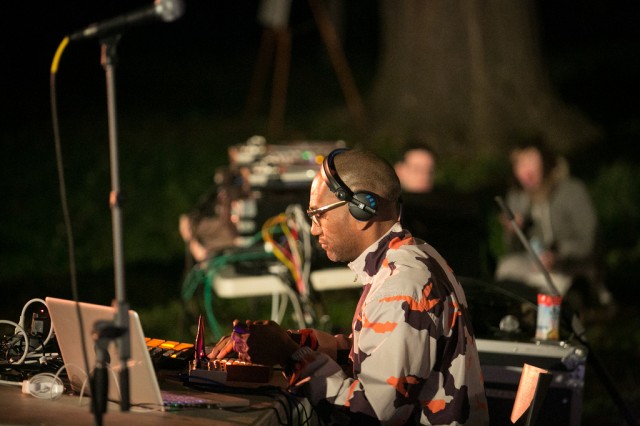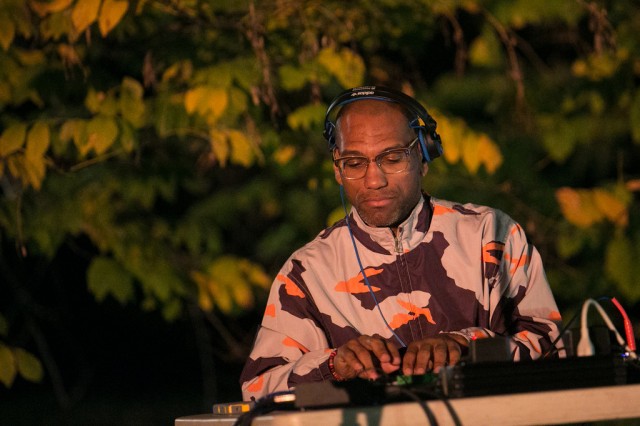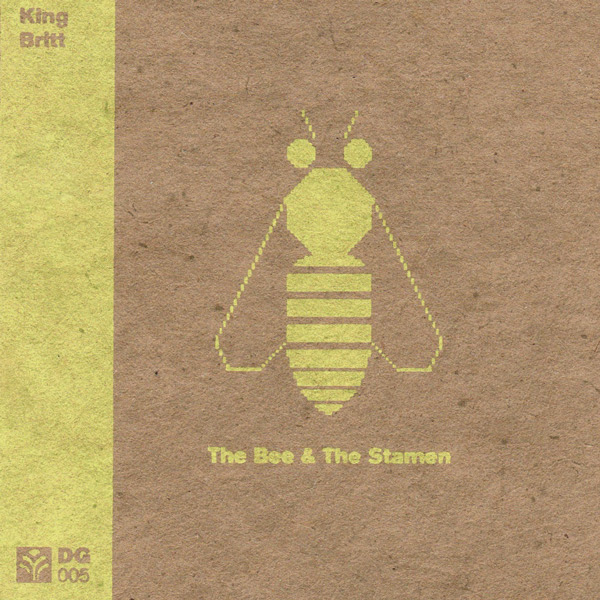For just a moment, take your mind somewhere a bit different.
First, imagine the computer as part of nature, not something separate from nature. And then, put your head inside the mind of a bee. (You might not want to operate heavy machinery, just in case you start to imagine you’re seeing things through a compound eye.)
That’s the journey we’re on with King Britt, the veteran producer from Philadelphia. He’s remixed everyone from Miles Davis to Tori Amos, but now, he remixes the world of the bee. And given how small we ultimately all are, perhaps that’s a worthy mission for a musician.
I’m pleased that we get to offer the exclusive, complete stream of the album. This seems to me one to buy in lossless quality, to enjoy in its entirety – even if many people no longer believe in such things. King also offers some insights into technology and nature that go well beyond the scope of this one record.
Peter: I think when most people think about synthesizers and computers, the last thing they imagine is something organic or natural. What does it mean for you to use these “artificial” technologies as a mirror to hold up to nature?
King: It’s funny, because a computer is made up of silicon, one of the most abundant elements on Earth, and copper, which is found in abundance in the Earth’s crust, is used for circuit boards. These are natural elements, which we don’t think of as natural because they are encased in plastic, but their ‘essence’ is organic in the beginning. So in a sense, once you know this fact, you dont think of the hardware as artificial. The funny thing is with the mirror idea, you’re essentially showing nature how it looks in a new outfit (plastic).
So, somehow, you’ve entered the mind of the bee. Since our lives are not terribly bee-like, how did you go about doing that? Did the foreignness of this help inspire you musically?
Lately, I have been listening to more sound design than music. So I got some cool plug-ins that were spectral processing things and really took any sound into a whole other sonic territory than I was used to. So, when I did Allogamy Sonics, it really sounded like a bees-in-a-hive situation. So then I started to think, what would a bee hear on his journey? “In Search of Stamen” is a perfect example. Quick movements from one idea to the other (using the monome) as if the bee was flying through the city….
The foreignness helped, for sure, as well as other ‘natural’ elements like cannibus.
Tell us a little bit about your musical journey. You’ve been a prolific producer for a long time. It’s funny, in a way, it sometimes seems like it’s the people I know who have had longer careers who are
the most adventurous, maybe because they don’t feel the need to fit some popular zeitgeist or prove themselves. How did you wind up at this point, and for those of you who don’t know you, how would you encapsulate some of the points in your career they should know?
I never think about what’s popular. I love popular music, but I just do what I feel. I love all genres and want to explore making music using this palette of knowledge. This knowledge, along with my DJ aesthetic, goes into my compositional process, which brings different results. Much of what I have done in the past like my Sister Gertrude Morgan Tribute or Sylk 130 stuff, was more digestive than, say, The Bee and the Stamen, but underneath, there was always sonic experimentation. It’s just that now, I’m stripping away more of the musical element down to its essence and putting more emphasis on sonic exploration, which is so much fun.
Not concerned so much with selling records or charting. But it always seems to work out in the end. I do it for the art and journey.

King Britt’s live rig, complete with monome and Ableton Live. Photo: Inna Spivakova, courtesy Data Garden.
What matters most to you musically these days? Listening to the record, it seems you’re really pushing sonic ideas as far as you can. When do you know you’ve pushed far enough?
Ha… you never know when you have pushed far enough, but after a while, you have to just stop and let it be. Musically, I have been studying more Musique Concrete stuff and found sounds, which I have been incorporating into my music since my Sylk130 days, and When The Funk Hits The Fan; [it] was a emotional picture. All the little skits were sound-designed from found sounds and real dialog.
Actually, I did a piece for TEDx last year with Saturn Never Sleeps, where the theme was the City. So I went all over Philadelphia to grab found sound rhythms and brought them into ableton and actually mapped out a days journey with rhythms. Then, Rucyl [Mills], the other half of SNS, sang over them… which gave it a wild sound.
I’m actually re-creating this and scoring it as we speak.
I know a bit about your tools and use of the monome, but specifically, what are we hearing on this record? It seems there’s a broad sound palette. What are the tools or techniques you’re employing?
So, initially I was experimenting with Michael Norris Spectral Plug-ins, which I had no idea how to use. Sometimes, it’s fun just to run things into these and find what works. So, the Allogamy Sonics is basically a rhythm from my Nintendo DS, and found sounds played on the monome, each running through a plug-in chain in Ableton. So I could group things then internally wired one into the other to get weird sh*t.
As far as textures, I have been creating my own loops using my synths running into things then sampling live into [monome patch] MLR. This is the case with most of the other songs, except Landing Grains, which is all Rhodes running through a series of Moogerfoogers and an Roland RE30 [Space Echo] ……and cannibus!
There are also some different sonic layers here; can you characterize some of these? Some are more fanciful, harmonic lines, others darker, glitchier shadows of timbres – do these have a narrative significance? Compositional significance?
Ha… well… Somethings I worked with various plug-ins, like [Native Instruments] Reaktor, which I create sounds and then run them into other things to then be sampled into MLR. So starting with one sound and then as its running in MLR, creating new sounds quickly on the fly and repeating until I have 5 for the song. This was more for the glitchy, techy stuff.
For the more harmonic [material], I pulled out a few synths and brought them into MLR, just to keep a sense of music. Then I would make samples of combinations, then resample myself. Ableton routing is just magnificent. Makes it all beautiful.
What are you working on otherwise – and are you somehow working this material into live performance? (That is, what did you perform this week?)
I performed some of this album live the other night at Switched On in Philly, which really went well. I was super nervous, because the version of MLR I was using is an altered Max for Live plug-in that sometimes isn’t stable, but it rocked! I was so happy in the end.
I wanted to sonically push more in the live show but considering the sound system and crowd, I may have blown some speakers and ears… I need to perfect that first.
The most fun was creating the architecture to actually do the performance in a smooth way without an [Akai] APC [Ableton controller]. So keymapping, knowing the MLR inside out, and creating multi-instrument racks is the key. Wow, that was the big discovery of bringing in like 20 VSTs into one rack and then mapping one knob to switch though them. Ableton wins again.
Any other impressions of interesting discoveries at the intersection of nature and sound at Switched on Garden?
Oh my God, Switched On is just so great. First, to be in a huge garden like that is amazing. Then to add something totally out-of-context like a synth is somehow very exciting, because it reminds you of science fiction movies, but it’s real. Then [to add] natural things, like the drum machine sequencer, where six people create a series of sequences that trigger little hammers to make beats on turtle shells…. genius. Everyone had fun!
Or mic’d cones that participants could alter the direction of the mics to then alter the sounds in the cones which changed each other…. c’mon …Alex curated the hell out of this year!
And most importantly, the kids loved it!
Video of the Live Show, Photos from Philly
King also shares with us some live video of the performance version of his work:
KING BRITT feat PIA ERCOLE live at SWITCHED ON GARDEN from King Britt on Vimeo.
This was a snippet from the live performance for my record release of The Bee and The Stamen at Switched On Garden 002 Festival. The event was curated and put on by Data Garden at Bartram Gardens in Philadelphia.
King Britt: Electronics, Monome and keys
Pia Ercole: Vocals
Video courtesy of Liz Hayes who happened to be filming
We spoke in our preview about the intersection of nature and music in this event; now, we have photos from The Switched-On Garden this month, by photographer Inna Spivakova. Slide show:
More information:
Data Garden (with more of this nature-meets-music goodness, and albums you can recycle by planting as seeds):
http://datagarden.org/
The Bee and the Stamen album page:
http://store.datagarden.org/album/the-bee-and-the-stamen
Twitter:
@DataGRDN
@KingBritt

